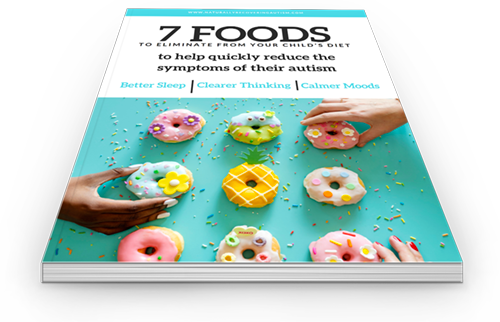Over 300 Chemicals Found in Babies’ Cord Blood [Podcast Episode #204].
The birth of a baby is a miraculous moment, yet recent research has shed light on a startling concern—more than 300 chemicals have been detected in babies’ cord blood and placenta at birth. This discovery highlights the fact that exposure to harmful chemicals begins much earlier than we previously thought.
From conception through pregnancy, toxins can pass from the mother to the fetus, raising concerns about their potential long-term effects on child development and health.
This episode will delve into the sources of these chemicals, their potential effects on babies, and how you can reduce exposure during pregnancy.
The Shocking Truth: What’s in Cord Blood?
Cord blood is a rich source of stem cells which help to regulate the immune system. Their responses shown in blood screening can be indicators of underlying coinfections of autism such as Lyme, mold, and strep.
These infections are often undetected in many traditional blood tests, but it can also contain toxic chemicals and environmental pollutants.
Studies, including the Environmental Working Group (EWG) investigation, have found traces of heavy metals, flame retardants, pesticides, and industrial compounds in the umbilical cord blood of newborns.
Out of the hundreds of chemicals detected, some include:
– Lead: A potent neurotoxin linked to developmental delays and cognitive issues.
– Mercury: Found in fish and industrial pollutants, it can affect brain development.
– Bisphenol A (BPA): Used in plastics, BPA has been associated with hormone disruption.
– Phthalates: Common in plastics and personal care products, they can disrupt the endocrine system.
– Polybrominated Diphenyl Ethers (PBDEs): Used in flame retardants, these chemicals can harm brain and thyroid development.
The fact that these chemicals are present in cord blood is alarming because it indicates that a fetus is exposed to these substances during critical periods of development.
How Do Chemicals Reach the Fetus?
During pregnancy, the placenta acts as a barrier, providing oxygen and nutrients to the fetus while filtering out certain harmful substances. However, this barrier is not foolproof. Many chemicals can cross the placenta, entering the baby’s bloodstream.
Here are some common sources of chemical exposure:
- Air Pollution: Particulate matter from car exhaust, industrial pollutants, and indoor air quality can affect both the mother and baby.
- Drinking Water Contaminants: Pesticides, glyphosate, heavy metals, plastics, and many more are in the water supply we ingest daily.
- Food Contaminants: Pesticides on fruits and vegetables, mercury in fish, and additives in processed foods can all introduce toxins into the body.
- Personal Care Products: Many everyday products, such as lotions, shampoos, and cosmetics, contain harmful chemicals like parabens and phthalates.
- Household Chemicals: Cleaning supplies, paints, and even furniture can emit volatile organic compounds (VOCs) that may be harmful during pregnancy.
Effects of Chemical Exposure on Babies
Research is ongoing, but we know that exposure to certain chemicals during pregnancy can have a range of adverse effects on a developing baby.
Some of these adverse effects include:
– Neurodevelopmental Issues: Lead, mercury, and other toxins have been linked to delayed cognitive development, lower IQ, anger and aggression.
– Hormonal Disruptions: Chemicals like BPA and phthalates can interfere with the endocrine system, potentially affecting reproductive health later in life.
– Respiratory Issues: Exposure to air pollutants has been linked to asthma and other respiratory conditions in children.
– Preterm Birth and Low Birth Weight: Certain toxins, like tobacco smoke and pesticides, have been associated with premature delivery and lower birth weight, which can impact a child’s long-term health.
Reducing Chemical Exposure During Pregnancy
While it’s impossible to eliminate all chemical exposure, there are ways to minimize it and protect both mother and baby:
- Eat Organic Foods: Organic produce is grown without synthetic pesticides and fertilizers, reducing your exposure to harmful chemicals.
- Choose Non-Toxic Personal Care Products: Opt for products that are free from phthalates, parabens, and other harmful chemicals. Look for “clean beauty” or “natural” labels.
- Filter Your Water: Drinking filtered water with a quality water filter can help reduce exposure to contaminants like lead, chlorine, and other industrial chemicals.
- Avoid Processed Foods: Processed foods can contain additives, preservatives, and BPA from packaging, so eating fresh, whole foods is a better option.
- Improve Indoor Air Quality: Keep your home well-ventilated, use air purifiers, and avoid using toxic cleaning supplies. Opt for eco-friendly and non-toxic alternatives.
- Limit Fish Consumption: While fish is a good source of omega-3s, certain types (such as swordfish and king mackerel) can contain high levels of mercury. Opt for safer options like salmon or sardines.
- Be Mindful of Plastics: Avoid using plastics that contain BPA and phthalates, especially when heating food, as chemicals can leach out into the food or drink.
The Importance of Education and Advocacy
The findings about chemicals in cord blood underscore the need for greater awareness and stronger regulations. Governments and organizations must work together to limit the use of harmful chemicals in consumer products and industrial processes.
Expecting parents can advocate for stricter environmental laws, support research on the health effects of chemicals, and push for clearer labeling on products.
Final Thoughts
Pregnancy is a time of joy and anticipation, but it’s also a time to be vigilant about environmental exposures. The discovery of over 300 chemicals in cord blood and the placenta is a wake-up call for all of us to pay closer attention to the toxins we are exposed to every day.
By making informed choices, reducing chemical exposure, and advocating for a healthier environment, we can help protect the next generation from harmful effects before they even take their first breath.
If you’re expecting or planning to conceive, now is the time to make changes in your lifestyle that will protect your baby’s health both before and after birth. Every small change can make a big difference!
♥
Also see:
Get Your Free Food Guide!
Quickly Reduce Your Child’s Symptoms of Autism by Eliminating 7 Foods Most People Consume Daily!
The first crucial step of autism recovery is to begin restoring health to the gut and the immune system.
The health of the gut is directly linked to the health of the brain and therefore to the symptoms of autism. In fact, 80% of the immune system comes from the gut so if the gut is not healthy, then the brain can’t thrive, and the immune system is compromised. It’s a vicious cycle, but thankfully, it’s one that we can put an end to by first eliminating harmful foods.
- Harmful Foods: Identify the foods that worsen autism symptoms and understand the science behind their impact.
- Smart Food Choices: Learn about easy dietary swaps that can significantly enhance sleep, clarity of thought, and emotional well-being.
- Practical Implementation: Get valuable tips on how to implement these dietary changes easily and effectively.
This is for informational purposes only and is not meant to diagnose or treat. Every child’s level of recovery is different. No two people are the same. It is never implied that all children will have the same outcome. Results are all based on individual biology and the work that is done. This process takes time and various steps, effort and resources need to be weighed. Our programs are intended to help you become more knowledgeable and guide you to help bring your child a better quality of life, whatever that may be. We want to help by giving great content, direction and strategies that move you forward. Nothing on this page or any of our websites is a promise or guarantee of results or future outcomes. The results on this page and any of our websites are not typical or promised. In fact, there will be people who purchase this and other programs and never put the work into implementing the strategies taught and therefore will achieve little to no results. Our more detailed earnings disclaimer, privacy policy, and terms and conditions for this program and website can be accessed via the links below. We hold ourselves (and you) to a high standard of integrity. We are cheering you on every step of the way.












